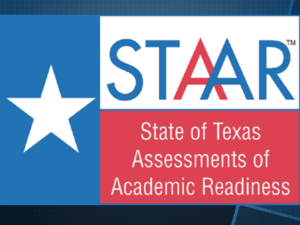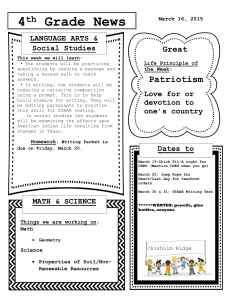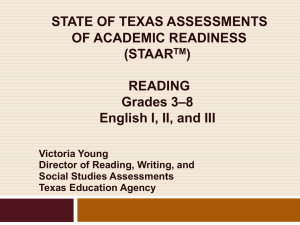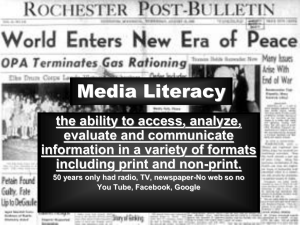ELA Update: TEKS and TAKS
advertisement
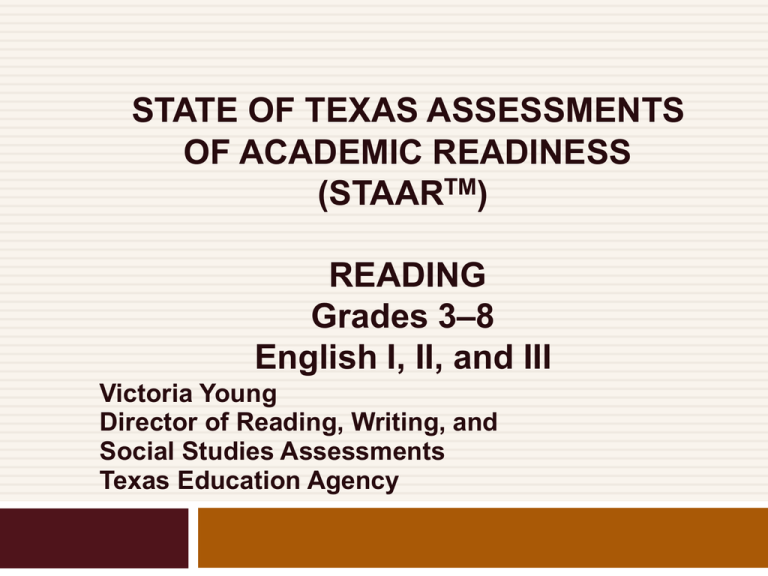
STATE OF TEXAS ASSESSMENTS OF ACADEMIC READINESS (STAARTM) READING Grades 3–8 English I, II, and III Victoria Young Director of Reading, Writing, and Social Studies Assessments Texas Education Agency 2 STAAR Reading Performance Spring 2012 Statewide Results Phase-in and Recommended Standards Grade/Course Phase-in Standard Recommended Standard Grade 3 76% 39% Grade 4 77% 42% Grade 5 77% 40% Grade 6 75% 38% Grade 7 76% 39% Grade 8 80% 43% English I 68% 46% The Big Picture—What Students Have to Know How To Do 3 Think critically/inferentially about different types of texts (in essence, know how to do more than literally read the lines: know how to read “between” the lines and “beyond” the lines) Make connections—at differing levels of depth and complexity—both within and across texts Understand what makes a connection between texts thematic or meaningful (and what doesn’t) Understand and be able to apply the specific academic vocabulary associated with literary and informational reading The Big Picture—What Students Have to Know How To Do 4 Understand that the way an author crafts a piece drives the way the reader reads it. Know that authors use different “tools” to craft different types of pieces (e.g., genres). Be able to identify these tools and pinpoint/articulate how they affect meaning. Understand the difference between effective text evidence and flawed text evidence. Know how to stay “inside” the text to find evidence that truly confirms the validity of an idea. Know how to find and use text evidence for different genres of reading. STAAR Short Answer Reading Performance Labels Based on the Rubric 5 Score Point 0—INSUFFICIENT Score Point 1—PARTIALLY SUFFICIENT Score Point 2—SUFFICIENT Score Point 3—EXEMPLARY The goal: moving all students from the lower half of the score-scale range (0 or 1) to the upper half of the range (2 or 3) What Short Answer Questions Require (and why they are essential to reading development at all levels) 6 To become good readers, students must understand what constitutes a credible IDEA in response to a question about a text or texts. An IDEA represents the quality and depth of thinking and understanding IDEA in a score of 3 on STAAR: perceptive, coherent, discerning, clearly analytical IDEA in a score of 2 on STAAR: reasonable and specific; goes beyond literal reading (even if it’s only slightly beyond) What Short Answer Questions Require (and why they are essential to reading development at all levels) 7 IDEA in a score of 1 on STAAR: lacks explanation or specificity; represents only a literal reading of the text IDEA in a score of 0 on STAAR: doesn’t answer the question; incorrect or invalid reading of the text; too general, vague, or unclear to judge whether it is reasonable What Short Answer Questions Require (and why they are essential to reading development at all levels) 8 To become good readers, students must by able to use TEXT EVIDENCE to prove that their ideas are valid/credible. TEXT EVIDENCE substantiates the reader’s ideas; it reflects the degree to which the reader can connect his or her own ideas with the pieces of the text that best support the analysis. What Short Answer Questions Require (and why they are essential to reading development at all levels) 9 TEXT EVIDENCE in a score of 3 on STAAR: specific and well chosen TEXT EVIDENCE in a score of 2 on STAAR: accurate and relevant TEXT EVIDENCE in a score of 1 on STAAR: only a general reference, too partial, weakly linked, or wrongly manipulates the meaning of the text TEXT EVIDENCE in a score of 0: either missing or not attached to an idea Why We Have to Include Text Complexity in the Conversation 10 If we want students to do on-grade-level work, we must teach them how to “tackle” increasingly complex texts each year. Text complexity is driven by a variety of factors: The author’s vocabulary/use of language may be more varied and challenging because it is nonliteral/figurative, abstract, academic, or technical Sentence structures may be more varied, dense, and sophisticated Why We Have to Include Text Complexity in the Conversation 11 The author’s use of literary elements/devices, rhetorical strategies, organizational patterns, and text features may be more nuanced or sophisticated The topic/content may be less familiar or more cognitively demanding Relationships among ideas may be less explicit and require more interpretation, reasoning, and inferential thinking to understand the subtlety, nuances, and depth of ideas What Students Have to Know for STAAR Reading—Some Specifics 12 Why does the author use a particular genre (e.g., literary nonfiction vs. expository, expository vs. persuasive)? Why does the author include a particular paragraph or paragraphs? Why does the author begin or end a piece in a particular way? Why does the author include a description of XX? What Students Have to Know for STAAR Reading—Some Specifics 13 How do a character’s relationships with other characters or motivations to take certain actions affect the plot/conflict/ outcome of a story? How does the author use dialogue to develop a particular character or the relationship between characters? How does the point of view from which the story is told affect the reader’s understanding of characters and events? What Students Have to Know for STAAR Reading—Some Specifics 14 What is the effect of setting on events/ characters/outcome of a story? How does a poet, playwright, or author use imagery, simile, metaphor, hyperbole, personification, time disruptions (flashback, foreshadowing) to create meaning? Why is XX ironic? How is XX symbolic? Which sentence best indicates, suggests, establishes, illustrates, describes, explains, expresses, supports, reflects, reveals, shows (“shows” at lower grades only)? What Students Have to Know for STAAR Reading—Some Specifics 15 What is significant (important) about XX? How does the author organize the selection? Why does the author organize the information in a particular way? Why does the author include a particular section (under a subheading) of an expository piece? What is the author’s attitude toward his/her subject? (attitude tone) What Students Have to Know for STAAR Reading—Some Specifics 16 How does the author’s use of particular words or phrases create a particular tone? How does the use of particular words affect meaning? Why does the author include quotations from particular people/entities/publications? Why does the author use particular rhetorical strategies—e.g., italics, ellipses, questions, comparisons/analogies, repetition, exaggeration? What Students Have to Know for STAAR Reading—Some Specifics 17 How does the author support each of his/her arguments? What is the author’s most convincing reason (and why)? Does the author make a convincing case for his position/opinion? What Students Have to Know for STAAR Reading—Some Specifics 18 Media/Procedural What is the tone of the photograph? What can the reader infer from the photograph and its caption? (At lower grades: The photograph helps the reader know XX.) Why does the author include the boxed information? Why does the author include a map? What can the reader conclude from the map? How does the embedded media or procedural element add to the reader’s understanding of the piece (or a section of the piece)? What Students Have to Know for STAAR Reading—Some Specifics 19 Connecting Selections What is one similarity or difference between the two selections or between the narrators/ speakers/characters/authors in the two selections? What is a theme or idea explored in both selections? Is the central message of the two selections the same? How does a particular quotation from one selection link/correspond thematically to a quotation from the other selection? The Link between Reading and Analytical Writing 20 The analytical writing task is an interpretive essay about one aspect of a literary or informational text. The analytical essay requires students to demonstrate the skills required in expository and persuasive writing as well as those required on short answer reading questions. The writer’s thesis statement must be a reasonable (though contestable) assertion about one aspect of a text that can be supported with textual evidence. The Link between Reading and Analytical Writing 21 The analytical writing task is an interpretive essay about one aspect of a literary or informational text. The analytical essay requires students to demonstrate the skills required in expository and persuasive writing as well as those required on short answer reading questions. The writer’s thesis statement must be a reasonable (though contestable) assertion about one aspect of a text that can be supported with textual evidence. The Link between Reading and Analytical Writing 22 Ineffective approaches confuse analysis and summary general text references and specific text evidence Students must integrate their analysis and their text evidence so that their essay is coherent. (This will also help their short answer reading responses—and their reading and writing performance in the lower grades.) Analytical essays are scored on the quality of the interpretation, the strength of the text evidence, and the overall effectiveness of the essay. CONTACT INFORMATION 23 Victoria Young Director of Reading, Writing, and Social Studies Assessments Texas Education Agency 512-463-9536 victoria.young@tea.state.tx.us
